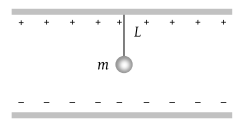A small sphere carrying a charge ‘q’ is hanging in between two parallel plates by a string of length L. Time period of pendulum is T0. When parallel plates are charged, the electric field between the plates is E and time period changes to T. The ratio T/T0 is equal to

(1) (2)
(3) (4) None of these

1. \(1\)
2. \(\sqrt{2}\)
3. \(4\)
4. \(2\)
A particle executes linear simple harmonic motion with an amplitude of of 3 cm. When the particle is at 2 cm from the mean position, the magnitude of its velocity is equal to that of its acceleration. Then, its time period in seconds is
1.
2.
3.
4.
A body mass m is attached to the lower end of a spring whose upper end is fixed. The spring has neglible mass. When the mass m is slightly pulled down and released, it oscillates with a time period of 3s. When the mass m is increased by 1 kg, the time period of oscillations becomes 5s. The value of m in kg is-
1.
2.
3.
4.
When two displacements represented by y1=asin(ωt) and y2=bcos(ωt) are superimposed,the motion is -
1. not a simple harmonic
2. simple harmonic with amplitude a/b
3. simple harmonic with amplitude
4. simple harmonic with amplitude (a+b)/2
The damping force on an oscillator is directly proportional to the velocity. The units of the constant of proportionality are
1.
2.
3.
4.
| 1. | simple harmonic motion of frequency \(\frac{\omega}{\pi}\). |
| 2. | simple harmonic motion of frequency \(\frac{3\omega}{2\pi}\). |
| 3. | non-simple harmonic motion. |
| 4. | simple harmonic motion of frequency \(\frac{\omega}{2\pi}\). |
The period of oscillation of a mass \(M\) suspended from a spring of negligible mass is \(T.\) If along with it another mass \(M\) is also suspended, the period of oscillation will now be:
1. \(T\)
2. \(T/\sqrt{2}\)
3. \(2T\)
4. \(\sqrt{2} T\)
1. \(\frac{\pi a\sqrt{3}}{2T}\)
2. \(\frac{\pi a}{T}\)
3. \(\frac{3\pi^2 a}{T}\)
4. \(\frac{\pi a\sqrt{3}}{T}\)
1. Acceleration \(=-k_0x+k_1x^2\)
2. Acceleration \(=-k(x+a)\)
3. Acceleration \(=k(x+a)\)
4. Acceleration \(=kx\)






